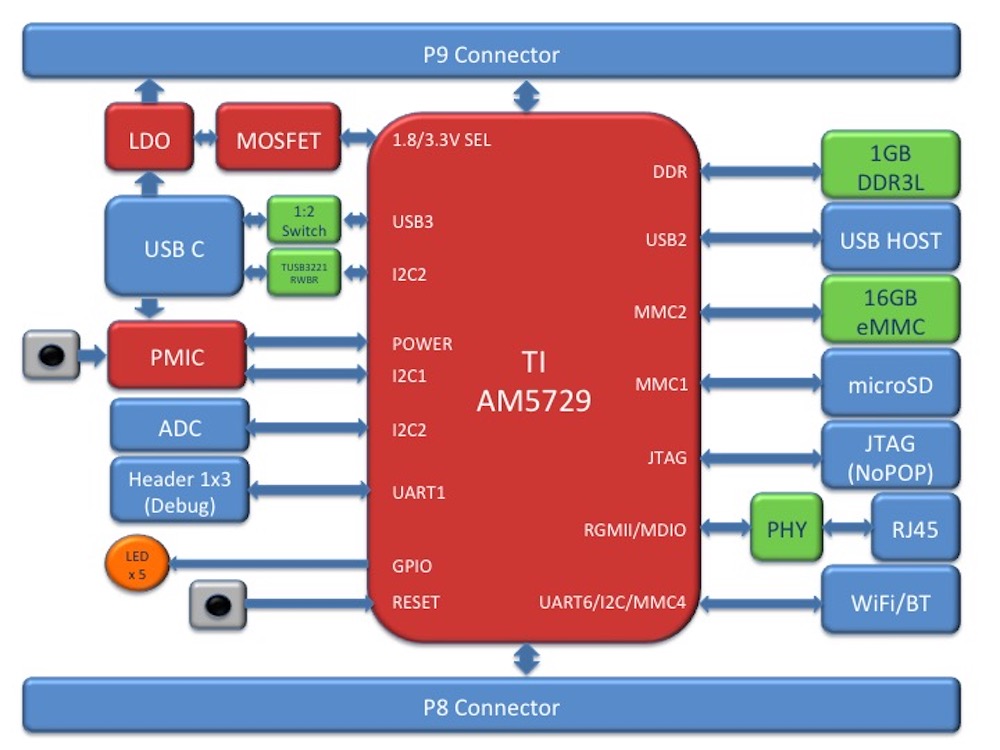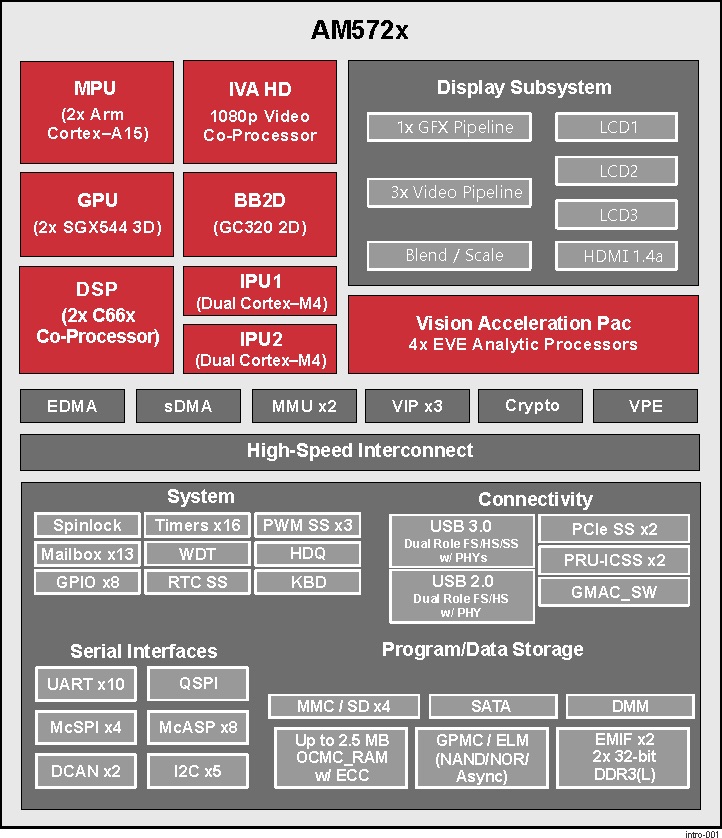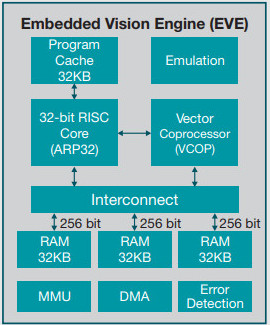BeagleBone AI High Level Specification¶
This section provides the high level specification of BeagleBone® AI
Block Diagram¶
The figure below is the high level block diagram of BeagleBone® AI. For detailed layout information please check the schematics.

AM572x Sitara™ Processor¶
The Texas Instruments AM572x Sitara™ processor family of SOC devices brings high processing performance through the maximum flexibility of a fully integrated mixed processor solution. The devices also combine programmable video processing with a highly integrated peripheral set ideal for AI applications. The AM5729 used on BeagleBone® AI is the super-set device of the family.
Programmability is provided by dual-core ARM® Cortex®-A15 RISC CPUs with Arm® Neon™ extension, and two TI C66x VLIW floating-point DSP core, and Vision AccelerationPac (with 4x EVEs). The Arm allows developers to keep control functions separate from other algorithms programmed on the DSPs and coprocessors, thus reducing the complexity of the system software.
Texas Instruments AM572x Sitara™ Processor Family Block Diagram*

MPU Subsystem The Dual Cortex-A15 MPU subsystem integrates the following submodules:
ARM Cortex-A15 MPCore
Two central processing units (CPUs)
ARM Version 7 ISA: Standard ARM instruction set plus Thumb®-2, Jazelle® RCT Java™ accelerator, hardware virtualization support, and large physical address extensions (LPAE)
Neon™ SIMD coprocessor and VFPv4 per CPU
Interrupt controller with up to 160 interrupt requests
One general-purpose timer and one watchdog timer per CPU – Debug and trace features
32-KiB instruction and 32-KiB data level 1 (L1) cache per CPU
Shared 2-MiB level 2 (L2) cache
48-KiB bootable ROM
Local power, reset, and clock management (PRCM) module
Emulation features
Digital phase-locked loop (DPLL)
DSP Subsystems There are two DSP subsystems in the device. Each DSP subsystem contains the following submodules:
TMS320C66x™ Floating-Point VLIW DSP core for audio processing, and general-purpose imaging and video processing. It extends the performance of existing C64x+™ and C647x™ DSPs through enhancements and new features.
32-KiB L1D and 32-KiB L1P cache or addressable SRAM
288-KiB L2 cache
256-KiB configurable as cache or SRAM
32-KiB SRAM
Enhanced direct memory access (EDMA) engine for video and audio data transfer
Memory management units (MMU) for address management.
Interrupt controller (INTC)
Emulation capabilities
Supported by OpenCL
EVE Subsystems
4 Embedded Vision Engines (EVEs) supported by TIDL machine learning library

The Embedded Vision Engine (EVE) module is a programmable imaging and vision processing engine. Software support for the EVE module is available through OpenCL Custom Device model with fixed set of functions. More information is available http://www.ti.com/lit/wp/spry251/spry251.pdf
PRU-ICSS Subsystems
2x Dual-Core Programmable Real-Time Unit (PRU) subsystems (4 PRUs total) for ultra low-latency control and software generated peripherals. Access to these powerful subsystems is available through through the P8 and P9 headers. These are detailed in Section 7.
IPU Subsystems There are two Dual Cortex-M4 IPU subsystems in the device available for general purpose usage, particularly real-time control. Each IPU subsystem includes the following components:
Two Cortex-M4 CPUs
ARMv7E-M and Thumb-2 instruction set architectures
Hardware division and single-cycle multiplication acceleration
Dedicated INTC with up to 63 physical interrupt events with 16-level priority
Two-level memory subsystem hierarchy
L1 (32-KiB shared cache memory)
L2 ROM + RAM
64-KiB RAM
16-KiB bootable ROM
MMU for address translation
Integrated power management
Emulation feature embedded in the Cortex-M4
IVA-HD Subsystem
IVA-HD subsystem with support for 4K @ 15fps H.264 encode/decode and other codecs @ 1080p60 The IVA-HD subsystem is a set of video encoder and decoder hardware accelerators. The list of supported codecs can be found in the software development kit (SDK) documentation.
BB2D Graphics Accelerator Subsystem The Vivante® GC320 2D graphics accelerator is the 2D BitBlt (BB2D) graphics accelerator subsystem on the device with the following features:
API support:
OpenWF™, DirectFB
GDI/DirectDraw
BB2D architecture:
BitBlt and StretchBlt
DirectFB hardware acceleration
ROP2, ROP3, ROP4 full alpha blending and transparency
Clipping rectangle support
Alpha blending includes Java 2 Porter-Duff compositing rules
90-, 180-, 270-degree rotation on every primitive
YUV-to-RGB color space conversion
Programmable display format conversion with 14 source and 7 destination formats
High-quality, 9-tap, 32-phase filter for image and video scaling at 1080p
Monochrome expansion for text rendering
32K × 32K coordinate system
Dual-Core PowerVR® SGX544™ 3D GPU The 3D graphics processing unit (GPU) subsystem is based on POWERVR® SGX544 subsystem from Imagination Technologies. It supports general embedded applications. The GPU can process different data types simultaneously, such as: pixel data, vertex data, video data, and general-purpose data. The GPU subsystem has the following features:
Multicore GPU architecture: two SGX544 cores.
Shared system level cache of 128 KiB
Tile-based deferred rendering architecture
Second-generation universal scalable shader engines (USSE2), multithreaded engines incorporating pixel and vertex shader functionality
Present and texture load accelerators
Enables to move, rotate, twiddle, and scale texture surfaces.
Supports RGB, ARGB, YUV422, and YUV420 surface formats.
Supports bilinear upscale.
Supports source colorkey.
Fine-grained task switching, load balancing, and power management
Programmable high-quality image antialiasing
Bilinear, trilinear, anisotropic texture filtering
Advanced geometry DMA driven operation for minimum CPU interaction
Fully virtualized memory addressing for OS operation in a unified memory architecture (MMU)
Memory¶
1GB DDR3L¶
Dual 256M x 16 DDR3L memory devices are used, one on each side of the board, for a total of 1 GB. They will each operate at a clock frequency of up to 533 MHz yielding an effective rate of 1066Mb/s on the DDR3L bus allowing for 4GB/s of DDR3L memory bandwidth.
16GB Embedded MMC¶
A single 16GB embedded MMC (eMMC) device is on the board.
microSD Connector¶
The board is equipped with a single microSD connector to act as a secondary boot source for the board and, if selected as such, can be the primary booth source. The connector will support larger capacity microSD cards. The microSD card is not provided with the board.
Boot Modes¶
Todo
Need info on BBAI boot mode settings
Power Management¶
Todo
Need info on BBAI power management
Connectivity¶
Todo
Add WiFi/Bluetooth/Ethernet
BeagleBone® AI supports the majority of the functions of the AM5729 SOC through connectors or expansion header pin accessibility. See section 7 for more information on expansion header pinouts. There are a few functions that are not accessible which are: (TBD)
Todo
This text needs to go somewhere.
Address |
Identifier |
Description |
|---|---|---|
0x12 |
U3 |
TPS6590379 PMIC DVS |
0x41 |
U78 |
STMPE811Q ADC and GPIO expander |
0x47 |
U13 |
HD3SS3220 USB Type-C DRP port controller |
0x50 |
U9 |
24LC32 board ID EEPROM |
0x58 |
U3 |
TPS6590379 PMIC power registers |
0x5a |
U3 |
TPS6590379 PMIC interfaces and auxiliaries |
0x5c |
U3 |
TPS6590379 PMIC trimming and test |
0x5e |
U3 |
TPS6590379 PMIC OTP |